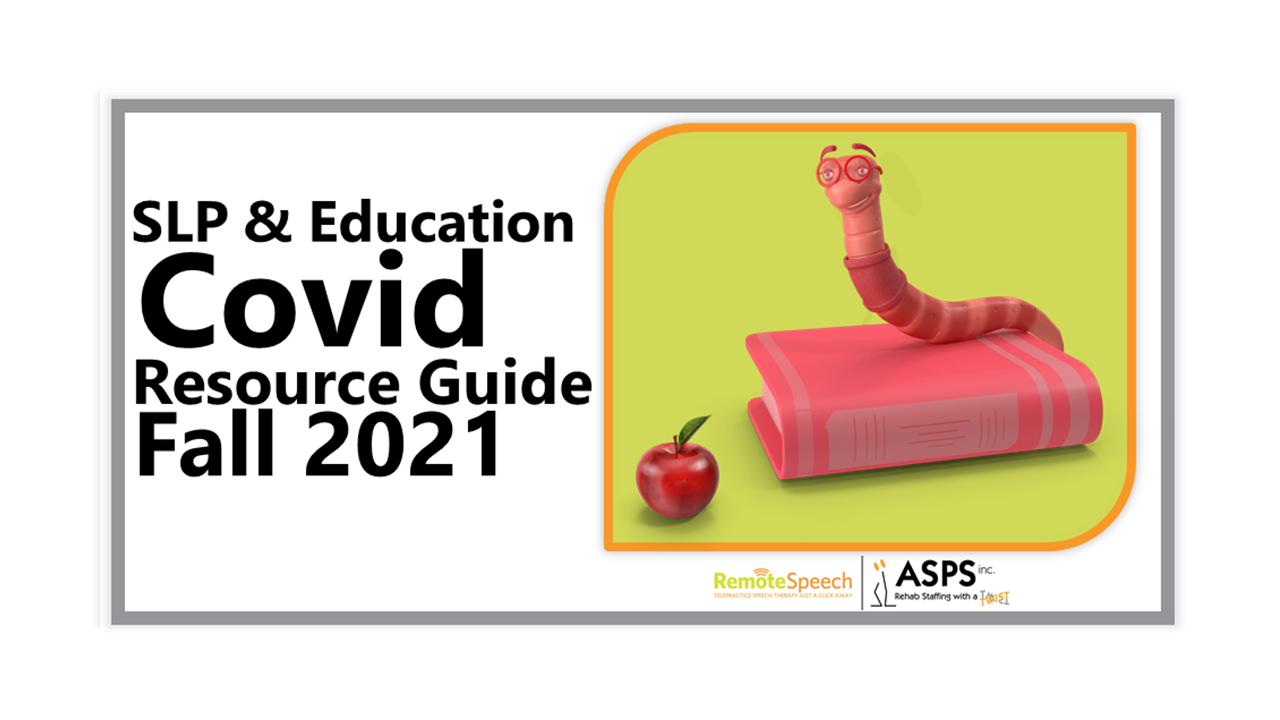
08
Oct
SLP and Education Covid Resource Guide – Fall 2021
Last year in 2020, we released the Educators Fall Guide to Speech Therapy- our objective was to help our strategic partners in both education and therapy with a “head start” with things to remember for the coming school year. We also released content such as the article titled: Adopting Telepractice in the Age of Covid 19, to provide some much-needed resources for educators and therapists alike.
As we enter the 2021-2022 school year, our team at Abington Speech Pathology and RemoteSpeech.com are taking stock. We are about 18 months into the pandemic; while we have made tremendous strides, we also recognize that we still have some blind spots as it pertains to the Covid pandemic and the new school year. This motivated us to draft a list of some excellent resources that may have gone unnoticed, to help parents, patients, educators, therapists, and administrators to arm themselves with the latest developments and resources available. Let’s begin!
AUDIOLOGY AND SPEECH-LANGUAGE PATHOLOGY SERVICE DELIVERY CONSIDERATIONS IN EARLY INTERVENTION DURING THE PANDEMIC
ASHA is here to assist audiologists and speech-language pathologists, who are key early intervention (EI) professionals, in modifying individualized family service plan (IFSP) services, planning alternate interventions, and supporting staff in learning new methods of remote and in-person service delivery. Federal Guidance on COVID-19 for Children With Disabilities Find information on states’ responsibilities to infants and toddlers with disabilities and their families/caregivers PDF], and to the staff serving these children in Part C programs, from the U.S. Department of Education (ED). Current ED guidance allows states to develop temporary solutions and exception policies to initial evaluation, assessment, re-assessment, and transition timelines without risk of noncompliance with federal regulations while the pandemic is ongoing. State Information State governments are considering federal guidance from the ED and the Centers for Disease Control and Prevention (CDC) as they take steps daily to address COVID-19 for their constituents, making this a highly fluid situation. Because of this, ASHA strongly recommends that members also look to leaders in their states, including their state/local health departments, EI lead agencies, local EI programs, and state licensing boards for specific information about serving their children and families/caregivers. Check ASHA's state-by-state information to find contact information for various state boards and agencies and current telepractice regulations. What to Do When EI Programs Are Open or Closed Under ED guidance, if the office of the state lead agency or EI program or provider is closed, EI services under Part C of the IDEA are not required. If the office remains open, and services cannot be provided in a particular location (e.g., the child’s home or childcare setting) or by a particular provider, the state lead agency must ensure continuity of services. If an office has closed, after it reopens the IFSP team determines whether the IFSP is still appropriate or needs updating. If a state’s EI system is open and operational, determining specific methods of service delivery (e.g., alternate location, different service provider, consultative services, telepractice) should be done on a case-by-case basis, consistent with the most updated public health and safety guidance, in coordination with the child, family/caregiver, and state lead agency or EI program/provider. You also need to follow existing payer policies and state and federal regulations for telepractice. Telepractice Considerations in Early Intervention There are special considerations for telepractice in EI settings. In addition to the child’s clinical presentation, clinicians need to consider their skills/competency (in various techniques, such as coaching, how families/caregivers feel about telepractice delivery, their access to technology, and their current responsibilities at home.- Colorado Part C program trainings
- National Center for Hearing Assessment and Management: A Practical Guide to the Use of Tele-Intervention in Providing Early Intervention Services to Infants and Toddlers Who Are Deaf or Hard of Hearing
- Ohio Developmental Disabilities Council
- Routines-Based Telepractice Visit Checklist (from Evidence-based International Early Intervention Office)
- The State of Telepractice for Delivering Early Intervention Services course, available with the ASHA Learning Pass
- Texas Part C program trainings
- Use of Telehealth in Early Intervention (IDEA Part C): Resources to Consider During the COVID-19 Public Health Emergency [PDF]
- Virginia Early Intervention Professional Development Center: COVID-19 and EI Tele-Intervention Updates
- Yes You Can! Routines-Based Intervention and Telepractice (Video)
- using caregivers to provide hands-on services or model activities under your direction
- using images or videos to demonstrate activities only using items (e.g., toys, books) that are already part of the child’s environment
- having sessions in outdoor spaces
- scheduling time between sessions to disinfect materials, wash hands, change clothes, etc.
- implementing a hybrid service delivery approach
- pairing the same providers with the same families/caregivers on a regular basis to minimize risk
- limiting the number of participants in the visit whenever possible
- Resuming In-Person Services During COVID-19: What to Consider As You Prepare
- Using Masks for In-Person Service Delivery During COVID-19: What to Consider
- ECTA's Considerations for Increasing In-Person Activities and Making Infrastructure Adjustments for Part C During COVID-19
- ITCA's Resources on In-Person Services for Part C Coordinators
ACCESS ADDITIONAL RESOURCES HERE
SUPPORTING STUDENTS DURING THE COVID-19 PANDEMIC: MAXIMIZING IN-PERSON LEARNING AND IMPLEMENTING EFFECTIVE PRACTICES FOR STUDENTS IN QUARANTINE AND ISOLATION
As the new school year begins, we must provide every student—from every community and background—the opportunity to safely learn in-person full-time. Abrupt shifts to remote learning over the past two school years have affected students, negatively impacting their social, emotional, and mental well-being and academic achievement. They have also exacerbated racial, socioeconomic, and other educational inequities. 1 Data collected before and during the COVID-19 pandemic have shown that in-person learning, on the whole, leads to better academic outcomes, greater levels of student engagement, higher rates of attendance, and better social and emotional well-being, and ensures access to critical school services and extracurricular activities when compared to remote learning. The U.S. Department of Education (Department) is committed to supporting states and school districts in offering in-person learning to all families and doing so safely by adopting science-based strategies for preventing the spread of COVID-19 that are aligned with the guidance from the Centers for Disease Control and Prevention (CDC). CDC guidance makes clear that K-12 schools should prioritize in-person learning, and that schools can safely operate in-person by implementing layered prevention strategies (using multiple strategies together consistently) in alignment with CDC recommendations. Studies show that schools that consistently implemented layered prevention strategies showed lower or similar levels of transmission than the communities in which they are located. This includes helping everyone eligible to get vaccinated, universal and correct indoor masking regardless of vaccination status 2, using contact tracing in combination with isolation and quarantine, improving ventilation, and maintaining physical distance to the maximum extent possible. It is important to emphasize that schools should take all deliberate action to prevent transmission and limit exposure within schools by implementing layered prevention strategies; doing so will help to prevent outbreaks and avoid interruptions to in-person learning in the first place. More information on how to protect the health and safety of students, educators, staff, and school communities can be found in the Department's Return to School Roadmap. Nevertheless, there may be situations when an individual or multiple members of a school community may need to isolate or quarantine due to positive COVID-19 cases. Isolation is a strategy used to separate people who have COVID-19 or symptoms of COVID-19 from those who are not infected or showing symptoms in order to prevent transmission of COVID-19. Quarantine is a strategy used to prevent transmission of COVID-19 by ensuring that unvaccinated people who have been in close contact with someone with COVID-19 stay apart from others. The decisions to isolate or quarantine should be made in coordination with guidance from state and local health officials in order to keep school communities safe and prevent the spread of COVID-19 in schools. It is important that students who are temporarily not attending school in-person due to isolation or quarantine (as well as students with other current health needs such as immunocompromised students and families) remain engaged and connected to learning with their peers and teachers in learning from home. Fortunately, there have been some examples over the past year that have shown promise for students and families, which can help inform strategies and best practices for other schools and districts. This document is intended to support states, school districts, and schools to maximize safe in-person learning opportunities by maintaining safe school operations and to implement effective practices that address students' social, emotional, mental health, and academic needs when students are temporarily not attending school in-person due to COVID-19 cases. Part 1: Maximizing In-Person Learning for All Students Schools are an important part of the infrastructure of communities, and safely returning to and remaining in in-person instruction should be a top priority for all communities. Schools provide safe and supportive learning environments for students that support social and emotional development, provide access to critical services, and improve life outcomes. They also employ people, and enable parents, guardians, and caregivers to work. Though COVID-19 outbreaks have occurred in school settings, as noted above, multiple studies have shown that transmission rates within school settings, when multiple prevention strategies are in place, are typically lower than or similar to community transmission levels. As CDC's science brief on Transmission of SARS-CoV-2 in K-12 Schools and Early Care and Education Programs shows, schools can reduce transmission by consistently implementing layered prevention strategies; this in turn will help students stay where they belong: safely learning in-person in the classroom. Here's What States, School Districts, and Schools Should Do to Maximize In-Person Learning for All Students: States, school districts, and schools working to safely reopen schools and maintain in-person instruction should include the following strategies in local operations plans consistent with health and safety guidelines. All of these strategies can be supported with funding from the American Rescue Plan Act of 2021 (ARP Act). The ARP Act provided states and school districts with nearly $122 billion in Elementary and Secondary School Emergency Relief (ESSER) funds 3 — flexible resources that, among other uses, may be used to implement public health protocols and policies in line with guidance from the CDC for the reopening and operation of school facilities to effectively maintain the health and safety of students and staff:- Avoid Outbreaks by Using Layered Prevention Strategies: Consistent with CDC guidance, prioritize offering in-person learning to all students by implementing layered prevention strategies from the very start of the school year. This includes helping everyone eligible to get vaccinated, universal and correct indoor masking, improving ventilation, physical distancing to the maximum extent possible (see below), implementing screening testing programs, contact tracing in combination with isolation and quarantine (see below), and more. Vaccination is the leading public health prevention strategy to end the COVID-19 pandemic. Promoting vaccination can help schools safely return to and sustain in-person learning as well as extracurricular activities and sports. CDC guidance includes strategies for promoting vaccination.
- Effectively Perform Contact Tracing, in Combination with Isolation and Quarantine, in Alignment with CDC Guidance: Decisions about when and which students should quarantine or isolate should be consistent with CDC guidance. The CDC guidance on contact tracing reinforces how universal masking policies benefit students, and that use of layered mitigation strategies helps prevent transmission in the first place to keep school communities safe and keep students learning in-person. It is also important to note that funds under the ARP Act may be used to support contact tracing efforts. CDC's latest toolkit will help schools effectively implement contact tracing, isolation, and quarantine.
- Use Cohorting, Seating Charts, and Other Strategies to Maintain Distancing and Minimize Spread Within School Buildings: Based on studies from the 2020-2021 school year, the CDC recommends schools maintain at least 3 feet of physical distance between students within classrooms, combined with indoor mask wearing to reduce transmission risk. When it is not possible to maintain a physical distance of at least 3 feet, such as when schools cannot fully reopen while maintaining these distances, it is especially important to layer multiple other prevention strategies, such as universal masking, screening testing, cohorting, improved ventilation, handwashing and covering coughs and sneezes, staying home when sick with symptoms of infectious illness including COVID-19, and regular cleaning to help reduce transmission risk. To the maximum extent possible, schools should cohort their students—meaning that they should keep people together in a small group and have each group stay together throughout an entire day to the extent possible. Cohorting can be used to limit the number of students, teachers, and staff who come in contact with each other, especially when it is challenging to maintain physical distancing, such as among young children, and particularly in areas of moderate-to-high transmission levels. Cohorts should not group students by perceived ability or in ways that perpetuate tracking. The use of cohorting can limit the spread of COVID-19 between cohorts but should not replace other prevention measures within each group. Seating charts can also help to effectively contact trace and understand which students were situated next to whom, especially in grades or circumstances where cohorts are not able to be maintained throughout the day (including in the cafeteria). Also, using additional spaces outside of the cafeteria for mealtime seating, such as the gymnasium or outdoor seating, can help facilitate distancing and reduce transmission during eating.
Access the complete report, including Part 2: Strategies for effective learning when students are temporarily Unable to Attend In-Person HERE
EDUCATION IN A PANDEMIC: THE DISPARATE IMPACTS OF COVID-19 ON AMERICA’S STUDENTS
On January 21, 2021, President Joseph R. Biden, Jr. issued Executive Order 14000, Supporting the Reopening and Continuing Operation of Schools and Early Childhood Education Providers, “to ensure that students receive a high-quality education during the COVID-19 pandemic, and to support the safe reopening and continued operation of schools, child care providers, Head Start programs, and institutions of higher education.” As a part of that order, the President directed the Assistant Secretary for Civil Rights in the Department of Education to “deliver a report … on the disparate impacts of COVID-19 on students in elementary, secondary, and higher education.” This Report answers that call. As is well known, COVID-19 upended classrooms and campuses across the country at the same time as the pandemic’s devastating effects were being felt in our nation’s economy and loss of life. In response, educators, staff, and school leaders at all educational levels and in all parts of the country have made extraordinary commitments and dedicated their talents, energy, and resources to address the needs of students and families in their communities. Parents, family members, and caregivers have done the same, supporting their students while responding to profound challenges in their own lives. Still, COVID-19’s impacts have fallen unevenly and preliminary data indicate that they appear to be deepening disparities in educational opportunity and achievement, many of them generations in the making. With the pandemic’s spotlight on these longstanding challenges, we have a rare moment as a country to take stock and to begin the hard work of building our schools back better and stronger—with the resolve necessary to ensure that our nation’s schools are defined not by disparities but by equity and opportunity for all students. In preparing this Report, the Office for Civil Rights (OCR) reviewed an array of publicly available sources documenting the impacts of COVID-19 on America’s students. Many of those sources reported findings from surveys or interviews of students, families, and educators from across the country. Additional sources supplied information about how the pandemic has disrupted educational practice in ways that are likely to limit students’ learning and achievement. Unless specifically noted, the findings and information presented here are not based on research conducted by the U.S. Department of Education. Nor is the discussion here offered as a comprehensive survey of research in the field. To the contrary, there are countless works in progress and even more to come that will enhance our understanding over time of the pandemic’s many effects on students. It is also important to note that none of the statements in this Report is intended to set forth a legal or policy judgment under any of the statutes OCR enforces or any other source of law. Instead, this Report, like the sources it discusses, tells part of a developing story by offering a series of snapshots from mid-March 2020, when many schools shifted abruptly to remote learning, to mid April 2021. This developing story prompts eleven observations about how widely—and inequitably—the pandemic appears to have impacted America’s students during this time. Report Summary: COVID-19 and K-12 Students: Barriers to Meaningful Access, Opportunities, and Outcomes..........1 COVID-19’s Widespread Effects on K-12 Students and Schools ........1 COVID-19’s Costs in Instructional Time, Access, and Content ...............1 COVID-19’s Toll on Student Well-being and Mental Health ........2 COVID-19 and Academic Achievement .........................4 Deepening Disparities for Students of Color...................6 Pre-Pandemic Disparities ............................................6 COVID-19 and The Deepening Gaps for Students of Color .......11 COVID-19’s Impact on English Learners ..............................18 Pre-Pandemic Disparities ........................................................18 COVID-19’s Amplification of Language Barriers .............20 Disparities for Students with Disabilities...........................22 Pre-Pandemic Disparities ........................................22 Disrupted Learning During the Pandemic............................25 COVID-19’s Impact on LGBTQ+ Students...............................27 Pre-Pandemic Disparities .......................................................27 Heightened Risks for LGBTQ+ Students During COVID-19..........29 COVID-19’s Disparate Impacts on Students in Higher Education......31 COVID-19 and Student Enrollment: Widespread Effects and Disparate Impacts ....32 COVID-19’s Impact on HBCUs, TCUs, and MSIs....................................35 COVID-19’s Impact on Students’ Financial Insecurity .................38 COVID-19 and Student Mental Health........................................43 COVID-19’s Disparate Impact on Mental Health for Students of Color ......................44 COVID-19’s Disparate Impact on LGBTQ+ Student Mental Health ..........45 Disparities in Experiences of Sexual Harassment and Sexual Violence..........47 Pre-Pandemic Concerns .....................................................................................47 |Impacts of COVID-19.............................................................................48 Disparate Impacts on Postsecondary Students with Disabilities ..........49 Pre-Pandemic Disparities ....................................................................49 COVID-19’s Impact on Students with Disabilities.........................49 Building Back For Equity in Educational Opportunity .................51Access the complete report here
COVID-19 AND EDUCATION: THE LINGERING EFFECTS OF UNFINISHED LEARNING
US states and districts have the opportunity to not only help students catch up on unfinished learning from the pandemic but also tackle long-standing historical inequities in education. Although the 2020–21 academic year ended on a high note—with rising vaccination rates, outdoor in-person graduations, and access to at least some in-person learning for 98 percent of students—it was as a whole perhaps one of the most challenging for educators and students in our nation’s history. Our analysis shows that the impact of the pandemic on K–12 student learning was significant, leaving students on average five months behind in mathematics and four months behind in reading by the end of the school year. The pandemic widened preexisting opportunity and achievement gaps, hitting historically disadvantaged students hardest. In math, students in majority Black schools ended the year with six months of unfinished learning, students in low-income schools with seven. High schoolers have become more likely to drop out of school, and high school seniors, especially those from low-income families, are less likely to go on to postsecondary education. And the crisis had an impact on not just academics but also the broader health and well-being of students, with more than 35 percent of parents very or extremely concerned about their children’s mental health. The fallout from the pandemic threatens to depress this generation’s prospects and constrict their opportunities far into adulthood. The ripple effects may undermine their chances of attending college and ultimately finding a fulfilling job that enables them to support a family. Our analysis suggests that, unless steps are taken to address unfinished learning, today’s students may earn $49,000 to $61,000 less over their lifetime owing to the impact of the pandemic on their schooling. The impact on the US economy could amount to $128 billion to $188 billion every year as this cohort enters the workforce. Federal funds are in place to help states and districts respond, though funding is only part of the answer. The deep-rooted challenges in our school systems predate the pandemic and have resisted many reform efforts. States and districts have a critical role to play in marshaling that funding into sustainable programs that improve student outcomes. They can ensure rigorous implementation of evidence-based initiatives, while also piloting and tracking the impact of innovative new approaches. Although it is too early to fully assess the effectiveness of postpandemic solutions to unfinished learning, the scope of action is already clear. The immediate imperative is to not only reopen schools and recover unfinished learning but also reimagine education systems for the long term. Across all of these priorities it will be critical to take a holistic approach, listening to students and parents and designing programs that meet academic and nonacademic needs alike. What have we learned about unfinished learning? As the 2020–21 school year began, just 40 percent of K–12 students were in districts that offered any in-person instruction. By the end of the year, more than 98 percent of students had access to some form of in-person learning, from the traditional five days a week to hybrid models. In the interim, districts oscillated among virtual, hybrid, and in-person learning as they balanced the need to keep students and staff safe with the need to provide an effective learning environment. Students faced multiple schedule changes, were assigned new teachers midyear, and struggled with glitchy internet connections and Zoom fatigue. This was a uniquely challenging year for teachers and students, and it is no surprise that it has left its mark—on student learning, and on student well-being. As we analyze the cost of the pandemic, we use the term “unfinished learning” to capture the reality that students were not given the opportunity this year to complete all the learning they would have completed in a typical year. Some students who have disengaged from school altogether may have slipped backward, losing knowledge or skills they once had. The majority simply learned less than they would have in a typical year, but this is nonetheless important. Students who move on to the next grade unprepared are missing key building blocks of knowledge that are necessary for success, while students who repeat a year are much less likely to complete high school and move on to college. And it’s not just academic knowledge these students may miss out on. They are at risk of finishing school without the skills, behaviors, and mindsets to succeed in college or in the workforce. An accurate assessment of the depth and extent of unfinished learning will best enable districts and states to support students in catching up on the learning they missed and moving past the pandemic and into a successful future. Students testing in 2021 were about ten points behind in math and nine points behind in reading, compared with matched students in previous years.ACCESS THE FULL REPORT HERE
PANDEMIC-RELATED SOCIAL AND COMMUNICATION CHALLENGES: HOW AUDIOLOGISTS AND SLPS CAN HELP WITH IN-PERSON LEARNING
The COVID-19 pandemic presents unique social and communication circumstances, which affect students in a variety of ways. Many students benefited from remote instruction and telepractice. Some of the bright spots of virtual learning and more time at home included increased family connections and communication;- more exposure to different languages in multilingual homes with the increased interaction time;
- more chances to discover new and creative ways to interact socially (e.g., via virtual platforms, talking to neighbors outside from a distance);
- more unique experiences to learn new vocabulary and conversational skills (e.g., talking about a variety of novel topics and emotions); and
- increased opportunities for English language learners and multilingual speakers to communicate in heritage languages. See Educating English Learner Students During the Pandemic: Remote and In-Person Instruction and Assessment (August et al., 2021).
- How will we determine the extent of lost instructional time on skill development?
- What considerations are necessary to ensure equity in access to instruction, resources, and technology?
- What are some considerations when working with English language learners?
- What interventions will be effective for transitioning back to in-person instruction?
- How can we measure progress?
REVIEW THE RESPONSES TO THESE QUESTIONS BASED PRIMARILY ON RESOURCES DEVELOPED BY THE U.S. DEPARTMENT OF EDUCATION FOR K–12 STUDENTS HERE
LONG COVID UNDER SECTION 504
A Resource to Support Children, Students, Educators, Schools, Service Providers, and Families The COVID-19 pandemic has created significant challenges for schools in meeting the needs of all children and students in early childhood, elementary, secondary, and postsecondary education. These challenges will continue as schools and public agencies seek to ensure support and equity for children and students experiencing the long-term adverse health effects of COVID-19, commonly referred to as long COVID. This resource is issued jointly by the U.S. Department of Education’s Office for Civil Rights (OCR) and the Office of Special Education and Rehabilitative Services (OSERS) to provide information about long COVID as a disability and about schools’2 and public agencies’ responsibilities for the provision of services and reasonable modifications to children and students for whom long COVID is a disability. The discussion here focuses on two Federal laws: Section 504 of the Rehabilitation Act of 1973 (Section 504) and Parts B and C of the Individuals with Disabilities Education Act (IDEA).3 Background: About Section 504 and IDEA Section 504 prohibits disability discrimination and ensures that students with disabilities have equal access to educational opportunities. In the education context, this law applies to schools that receive Federal financial assistance from the Department and is enforced by the Department’s OCR. IDEA Part B ensures that a free appropriate public education (FAPE) is available to all children with disabilities residing in the State between the ages of 3 through 21 years, with a few specific exceptions, and including children with disabilities who have been suspended or expelled from school.8 Under Part C of the IDEA, infants and toddlers (birth through age 2 years) with disabilities and their families are eligible to receive early intervention services. 9 OSERS’ Office of Special Education Programs (OSEP) administers the IDEA, including the Federal Special Education Grants to States under Part B and Special Education Grants for Infants and Toddlers under Part C What Is Long COVID and What Is Its Impact on Children and Students? The U.S. Centers for Disease Control and Prevention (CDC) has identified long COVID as another term for post-COVID conditions.10 According to the CDC, post-COVID conditions “are a wide range of new, returning, or ongoing health problems people can experience more than four weeks after first being infected with the virus that causes COVID-19. Even people who did not have symptoms when they were infected can have post-COVID conditions.” Preliminary studies show that children and students of all ages may experience long COVID, which can produce a combination of symptoms, including: -Tiredness or fatigue -Difficulty thinking or concentrating (sometimes referred to as “brain fog”) -Headache -Changes in smell or taste -Dizziness on standing (lightheadedness) -Fast-beating or pounding heart (also known as heart palpitations) -Symptoms that get worse after physical or mental activities -Chest or stomach pain -Difficulty breathing or shortness of breath -Cough -Joint or muscle pain -Mood changes -Fever -Pins-and-needles feeling -Diarrhea -Sleep problems -Changes in period cycles -Multiorgan effects or autoimmune conditions -Rash As the Departments of Justice and Health and Human Services explain, long COVID can be a disability under the Americans with Disabilities Act and Section 504 of the Rehabilitation Act of 1973.READ RECOMMENDATIONS, INCLUDING PROTECTIONS AND SERVICES UNDER IDEA AND SECTION 504 FOR CHILDREN AND STUDENTS WITH LONG COVID, WHAT TO DO IF A CHILD OR STUDENT IS EXPERIENCING LONG COVID AND MORE, BY ACCESSING THE FULL REPORT HERE
USING MASKS FOR IN-PERSON SERVICE DELIVERY DURING COVID-19 PANDEMIC: WHAT TO CONSIDER
As of July 27, 2021, the Centers for Disease Control and Prevention (CDC) recommends the use of masks for all teachers, staff, students, and visitors to K–12 schools regardless of whether they have been vaccinated to help mitigate the transmission of COVID-19. The CDC also has new guidance for fully vaccinated people, especially for those in high transmission areas. The CDC continues to recommend the use of masks by all individuals in health care settings. Local rules and regulations may require all individuals to use masks in certain situations. Businesses and workplaces, including private practices, can set their own policies. Use of masks is especially important when it isn’t possible to follow physical distancing standards. School and Public Policy on Mask Use ASHA recommends adhering to the most current CDC guidelines to inform policies for the use of masks across all school and public settings. Questions have arisen regarding a possible connection between mask use by those who interact with young children (e.g., teachers, caregivers, daycare providers) and delays in speech, language, and social development for children with typically developing speech, language, and hearing. The American Academy of Pediatrics (AAP) and ASHA collaborated on an article regarding this issue, Do Masks Delay Speech and Language Development? (see the reference section below for pertinent research). These are the conclusions by the AAP and ASHA:- While this is a natural concern, there is no evidence that use of face masks prevents or delays speech and language development.
- Babies and young children study faces intently, so the concern about solid masks covering the face is understandable. However, there are no known studies that show that use of a face mask negatively impacts a child's speech and language development.
- Babies and toddlers can get all the face time they need in the home with family members who aren't wearing face masks.
- Regardless of mask use, some children will take longer to reach speech and language milestones—and some may need help meeting them.
- When it comes to use of face masks, the bottom line is safety first! Masks reduce transmission of COVID-19 and can make in-person schooling possible.
Review the complete report for additional considerations for mask use while providing in person service delivery, including:
- Types of Masks
- Service Delivery Considerations
- Choosing the Right Mask for the Service You’re Providing
- Making Sure PPE Is Available for the Client/Student and Provider
- Determining Whether PPE Negatively Affects a Service
- Options for Modification
- Taking Steps to Enhance Communication While Wearing Masks


 The response to the COVID-19 virus is unprecedented. Because of our unique role in children’s K-12 education, we feel a responsibility to do what we can to assist schools, therapists, and students with this transition to online learning and seclusion. To ensure that our clients remain engaged and supported, our therapists will be providing complimentary “Support Sessions” to the country’s youth. We will also be assisting schools by training therapists for remote therapy.
The response to the COVID-19 virus is unprecedented. Because of our unique role in children’s K-12 education, we feel a responsibility to do what we can to assist schools, therapists, and students with this transition to online learning and seclusion. To ensure that our clients remain engaged and supported, our therapists will be providing complimentary “Support Sessions” to the country’s youth. We will also be assisting schools by training therapists for remote therapy.


